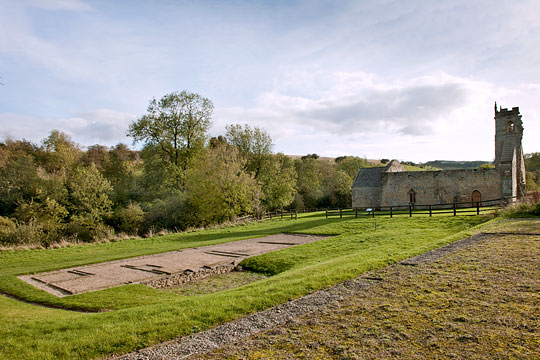Research on Wharram Percy Deserted Medieval Village
The intensive campaign of survey, excavation and documentary research focused on Wharram Percy since 1948 has resulted in a series of 13 major reports[1] and several other highly influential articles and books.[2] Few historic sites, of any type, have seen such extensive publication of either data or changing interpretations. Despite this level of study, however, many gaps in knowledge remain about particular buildings and features, as well as events in the village’s history.

Current State of Knowledge
Although a few other deserted medieval villages have been more completely excavated, Wharram Percy can still claim to be one of the best understood, largely as a result of the intensity of scholarship invested in it.
The development of the church is particularly well understood, as is the site’s post-medieval history.[3] Scientific analysis of the bones from 687 skeletons recovered from the church and graveyard has revealed a wealth of detail about life and death in the medieval village. Most recently, analysis of some of the skeletal remains has shown that the corpses were burnt and mutilated before burial. The researchers believe that this may represent the first scientific evidence in England of attempts to prevent the dead arising from their graves and harming the living.
Documentary research has revealed the outline of Wharram’s history from 1066 to the mid-16th century, but much remains to be understood about the medieval village’s rise and fall. Still less is known about earlier periods.
One of the key objectives of the Wharram Research Project (see Significance of Wharram Percy Deserted Medieval Village) was to elucidate the everyday life of the typical medieval peasant, and the excavation of the longhouse (Building 6) was inextricably linked with this objective. Ironically, this house seems to have been exceptionally large by the standards of those preserved as earthworks, and of relatively high status, to judge from the artefacts recovered there; so the nature of life for the poorer peasants remains less well understood.[4]
Potential for Future Research
Some of the later excavations were informed by earthwork and geophysical survey, as would normally be the case today. Comprehensive and analytical surveys, however, were carried out nearly a decade after completion of the excavations. Thus they served both to contextualise earlier excavations and to raise new questions that could still be addressed through future excavations.
The potential for future research is addressed in the final report on the excavations.[5] Key unresolved questions concern:
- The origins of the medieval village: what was the true nature of the Middle Saxon (7th-century) settlement – permanent or seasonal? Where did the Late Saxon (9th- to 10th-century) people responsible for building the early churches live? How was the so-called ‘village moment’ (ie its foundation) reflected in the wider landscape?
- The interplay between the South and North Manors: when was the latter built and how did it develop? How was the site of the North Manor used immediately before the manorial complex was established there?
- West Row (south): what was the nature of peasant life here, if (as seems to be the case) the houses were atypically large and luxurious and not laid out in a conventional row?
- What was life like for the villeins living in West Row (north) and North Row and the cottars (perhaps) living in East Row, who made up the majority of the population? Can current theories about when these rows were established, based largely on earthwork survey, be confirmed through excavation?
Although these major questions remain inadequately answered, there is a consensus that for the time being further fieldwork at Wharram would be premature, and that research should focus on the existing physical and paper archive. It seems likely that provisional answers to some of the questions outlined above will come from fieldwork elsewhere on the Wolds and further afield.
READ MORE ABOUT WHARRAM PERCY DESERTED MEDIEVAL VILLAGE
Footnotes
1. The last in this series – S Wrathmell (ed), Wharram XIII: A History of Wharram Percy and its Neighbours (York, 2012) – presents reappraisals of much of the earlier work and offers a gateway to the previous volumes, which are listed in Sources for Wharram Percy Deserted Medieval Village.
2. For example M Beresford, The Lost Villages of England (London, 1954); M Beresford and J Hurst (eds), Deserted Medieval Villages (London, 1971).
3. D Stocker and P Everson, ‘A new understanding of the church fabric’, in Wharram XIII, 240–62.
4. S Wrathmell (ed), Wharram VI: Domestic Settlement 2: Medieval Peasant Farmsteads (York, 1989); S Wrathmell, ‘The houses of Wharram’s tenant farmers at the end of the Middle Ages’, in Wharram XIII, 340–41.
5. S Wrathmell, ‘Wharram and the Wolds: future research potential’, in Wharram XIII, 365–7.